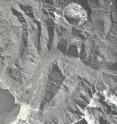Chile's Chaiten volcano one of scores of active volcanoes in region, says CU-Boulder professor
The Chaiten volcano now erupting in southern Chile is one of 200 to 300 volcanoes in the "Andean Arc" region of Chile, Peru, Ecuador and Columbia considered active by volcanologists, some of which lie in much more densely populated areas, said a University of Colorado at Boulder geologist who has studied Chaiten. While the public perception is that volcanoes that have not erupted in historic times are dormant, volcanologists consider any volcanoes that erupted during the last 10,000 years during the Holocene Period -- including Chaiten -- to be potentially active, said CU-Boulder geological sciences department Professor Charles Stern.
Stern said the pyroclastic flow and ash-fall deposits he and Chilean colleagues analyzed in 2004 indicate Chaiten last erupted about 9,370 years ago. "We consider the lifespan of Andean volcanoes to be about 1 million years, which is supported by this new eruption," he said.
He said Chaiten, which started to erupt on Friday and which "ramped up significantly" today, could bury the nearby town of Chaiten much like the Roman city of Pompeii was buried by tephra, or volcanic material, following the eruption of Mount Vesuvius in 79 A.D.
"There are 25 million to 30 million people that live very close to at least one of these potentially active volcanoes in the Andean Arc, including the cities of Quito and Santiago," said Stern. "This is a good example of what could happen at any time in the region, and it is fortunate the Chaiten eruption is occurring in a pretty sparsely populated area."
Only a few dozen of the 200 to 300 active volcanoes in the Andean Arc are actively monitored, said Stern. More than 25,000 people were killed by the eruption of the Nevado del Ruiz volcano in Columbia in 1985, he said.
By Tuesday morning Chilean authorities had evacuated more than 4,000 people from the region, including the population in the town of Chaiten six miles from the volcano and the town of Futaleufo, roughly 70 miles to the east near the Argentine border. The five-day eruption of Chaiten has sent a thick column of ash and smoke into the stratosphere moving east across Patagonia to the Atlantic Ocean.
"The volcano went into a higher state of activity this morning," Stern. "What happens after today is anybody's guess."
In addition to covering towns and villages and polluting air and water, the ash fall will undoubtedly affect agricultural and ranching activities, Stern said. "Because there is relatively little precipitation in the region of Patagonia east of the volcano, it will take a long time to naturally wash the ash from the landscape."
Stern and Jose Naranjo of the National Service of Geology and Mining, who published a 2004 paper in the journal "Geology of Chile," used radiocarbon methods to date the last eruption of Chaiten and concluded the eruption generated layers of volcanic tephra on the surrounding landscape up to five feet thick. The same prehistoric eruption apparently created the two-mile-diameter crater where the current eruption is centered, the authors said.
Stern said the possibility of the Chaiten volcano affecting Earth's climate is probably fairly low. "In to order to significantly affect the climate, a volcano has to put out a lot of sulfur dioxide aerosols into the stratosphere for an extended period, which then reflects sunlight away from the Earth," he said. "Our data from Chaiten showed the last eruption was high in silica and low in sulfur."
In contrast, the massive eruption of Mount Pinatubo in the Philippines in 1991 cooled the global climate for about one year because of high sulfur dioxide emissions, he said. The eruption of Tambora in Indonesia in 1815 affected the world's climate for about three years and caused what is known as the Year Without a Summer in 1816 by cooling Europe and North America with huge atmospheric sulfur dioxide emissions.
Source: University of Colorado at Boulder
Articles on the same topic
- Chilean volcano captured blasting ashThu, 8 May 2008, 13:28:34 UTC
Other sources
- Livestock, Pets Left Behind As Chile Volcano Fears Loomfrom National GeographicFri, 9 May 2008, 20:21:03 UTC
- Chile gives volcano holdouts ultimatum to fleefrom Reuters:ScienceFri, 9 May 2008, 1:35:05 UTC
- Chilean volcano captured blasting ashfrom PhysorgThu, 8 May 2008, 15:42:09 UTC
- Chilean Volcano Captured Blasting Ashfrom Science DailyThu, 8 May 2008, 14:35:32 UTC
- Chilean volcano captured blasting ashfrom European Space AgencyThu, 8 May 2008, 8:56:31 UTC
- Military evacuated as Chile volcano eruption flaresfrom Reuters:ScienceThu, 8 May 2008, 8:56:20 UTC
- Chaiten volcano erupts in Chilefrom LA Times - ScienceWed, 7 May 2008, 16:28:15 UTC
- Chile's Chaiten volcano one of scores of active volcanoes in regionfrom PhysorgWed, 7 May 2008, 15:21:24 UTC
- Chile's Chaiten Volcano One Of Scores Of Active Volcanoes In Regionfrom Science DailyWed, 7 May 2008, 15:21:09 UTC
- PHOTOS: Chile Volcano Erupts With Ash, Lava, Lightningfrom National GeographicWed, 7 May 2008, 12:42:13 UTC
- Emergency evacuation as Chile volcano spits lavafrom Reuters:ScienceWed, 7 May 2008, 0:42:06 UTC
- Volcano Erupts in Chile; Spews Ash 12 Miles Upfrom National GeographicTue, 6 May 2008, 20:56:15 UTC
- Chile Volcano Eruption Sends Residents Fleeing, Causes One Death [News]from Scientific AmericanTue, 6 May 2008, 17:14:06 UTC
- Volcano in Chile spews lava and blasts ash 12 miles into skyfrom AP ScienceTue, 6 May 2008, 15:21:14 UTC
- New evacuation as Chile volcano spews lava: reportfrom Reuters:ScienceTue, 6 May 2008, 13:35:13 UTC
- Erupting volcano prompts new evacuation in Chilefrom Reuters:ScienceMon, 5 May 2008, 18:21:11 UTC
- Thousands evacuated as Chile volcano spews ashfrom Reuters:ScienceSun, 4 May 2008, 0:42:04 UTC
- Chilean volcano town nearly desertedfrom AP ScienceSat, 3 May 2008, 22:21:03 UTC
- Rumbling volcano forces evacuation of southern Chilean townfrom PhysorgSat, 3 May 2008, 21:07:06 UTC
- Thousands evacuated as Chile volcano spews ashfrom Reuters:ScienceSat, 3 May 2008, 16:56:04 UTC
- Chilean volcano belches ash, forces evacuationfrom Reuters:ScienceFri, 2 May 2008, 17:35:04 UTC
